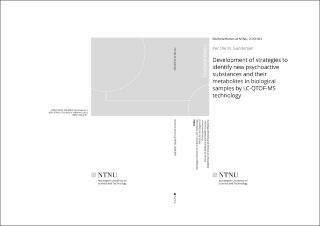| dc.description.abstract | New psychoactive substances (NPS) are emerging in the illegal drug market, which has led to major challenges for analytical laboratories. Keeping screening methods up to date with all relevant drugs is hard to achieve and the risk of missing important findings in biological samples is a matter of concern. Certain groups of NPS, e.g., synthetic opioids including fentanyl analogues, are of special concern due to their high potency. This indicates the possibility of low drug concentrations in vivo and calls for sensitive analytical methods and identification of the most appropriate analytical targets. In this thesis, three studies were carried out to demonstrate the application of liquid chromatography quadrupole time-of-flight mass spectrometry (LC-QTOF-MS) technology in the detection of NPS and their metabolites.
In Study I, a sensitive and quantitative screening method in urine with metabolites of synthetic cannabinoids that were frequently seized in Norway in the current time period (ABFUBINACA, AB-PINACA, AB-CHMINACA, AM-2201, AKB48, 5F-AKB48, BB-22, JWH-018, JWH-073, JWH-081, JWH-122, JWH-203, JWH-250, PB-22, 5F-PB-22, RCS-4, THJ-2201, and UR-144) was developed. The samples were treated with ß-glucuronidase prior to extraction and solid-phase extraction was used. Liquid handling was automated using a robot. Each sample was initially screened for identification and quantification, followed by a second injection for confirmation. The concentrations by which the compounds could be confirmed varied between 0.1 and 12 ng/ml. Overall, the validation showed that the method fulfilled the set criteria and requirements for matrix effect, extraction recovery, linearity, precision, accuracy, specificity, and stability. One thousand urine samples from subjects in drug withdrawal programs were analysed using the presented method. The metabolite ABFUBINACA M3, hydroxylated metabolite of 5F-AKB48, hydroxylated metabolite of AKB48, AKB-48 N-pentanoic acid, 5F-PB-22 3-carboxyindole, BB-22 3-carboxyindole, JWH-018 N- (5-hydroxypentyl), JWH-018 N-pentanoic acid, and JWH-073 N-butanoic acid were quantified and confirmed in 2.3% of the samples. The method was proven to be sensitive, selective, and robust for routine use for the investigated metabolites.
In Study II, the in vitro metabolism of ortho-, meta-, and para-fluorofentanyl - three fluorinated derivatives of fentanyl - was investigated using human hepatocytes and compared to the results from an authentic urine sample from a human individual with a confirmed intake. The three fluorofentanyl isomers were incubated with pooled human hepatocytes at 1, 3, and 5 h. LC-QTOF-MS operating in data-dependent mode was used to analyse the hepatocyte samples, as well as the authentic urine sample. Data were analysed by a targeted approach with a database of potential metabolites. The major metabolite formed in vitro was the N-dealkylation product norfluorofentanyl. In addition, various hydroxylated metabolites, an N-oxide, dihydrodiol metabolites, and a hydroxymethoxy metabolite were found. In the authentic urine sample, the hydroxymethoxy metabolite, norfluorofentanyl, and a metabolite hydroxylated on the ethylphenyl ring were detected. The study showed that the metabolic pattern for ortho-, meta-, and para-fluorofentanyl was close to those previously reported for other fentanyl analogues. The hydroxymethoxy metabolite and the metabolite hydroxylated on the ethylphenyl ring stand out as the metabolites that should be investigated further to determine the most appropriate marker for intake of fluorofentanyl derivatives in urine drug screening for human subjects.
In Study III, a strategy for extended retrospective data analysis of data files acquired by LCQTOF- MS was developed. Diagnostic fragment ions from synthetic cannabinoids (n=251), synthetic opioids (n=88), and designer benzodiazepines (n=26) were obtained from the crowdsourced database HighResNPS.com and converted to a personalized library in a format compatible with the analytical instrumentation. Data files from the analysis of 1314 forensic post-mortem samples performed at the Department of Clinical Pharmacology from January 2014 to December 2018 were retrieved and retrospectively processed with the new personalized library. Potentially positive findings were grouped into category 1 (most confident) and category 2 (less confident) depending on the information available in the files. Five new findings of category 1 were identified: flubromazepam in two data files from 2015 and 2016, respectively, phenibut (4-amino-3-phenylbutyric acid) in one data file from 2015, fluorofentanyl in one data file from 2016, and cyclopropylfentanyl in one data file from 2018. Retention time matches with reference standards further strengthened these findings. One category 2 finding of phenibut was considered plausible after the checking of retention times and signal-to-noise ratios, whereas 34 other potentially category 2 findings were refuted after a closer evaluation. This study showed that new compounds can be detected retrospectively in data files from LC-QTOF-MS using an updated library containing diagnostic fragment ions. | en_US |
